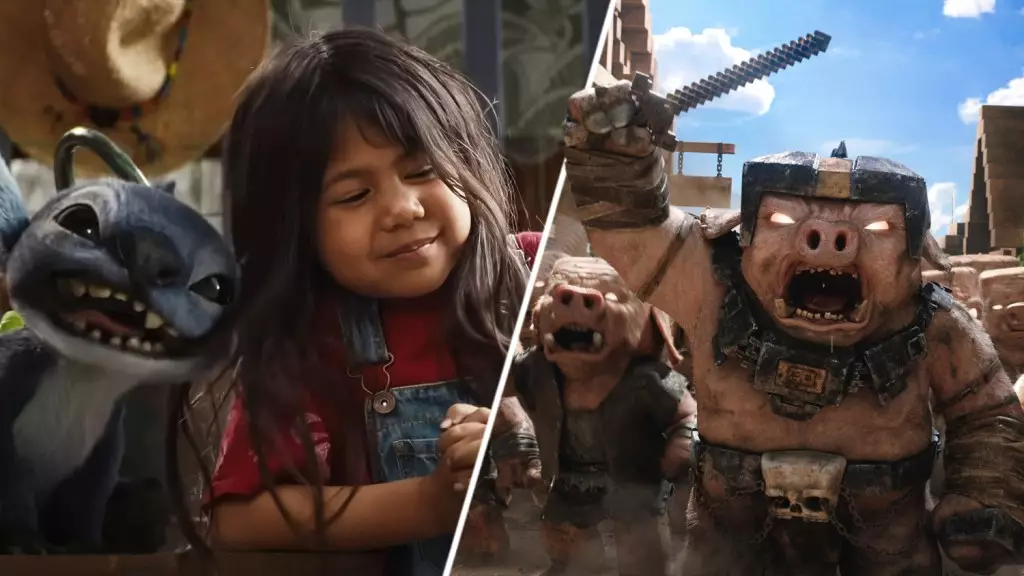In a landscape where traditional box office revenues continue to fluctuate unpredictably, Disney’s latest strategy—focusing on beloved nostalgic properties—has proven to be a masterstroke. The recent performance of “A Lilo & Stitch” exemplifies how leveraging established franchises can provide stability amidst economic and industry upheaval. As the industry struggles with residual pandemic effects, strikes, and shifting consumer habits, Disney’s ability to repackage nostalgia into blockbuster success underscores a calculated, centrist approach rooted in balancing innovation with proven IP.
The movie’s sustained presence in theaters—now in its sixth week—reflects a strategic win, especially considering the fickle nature of modern audiences. It’s no accident that Disney’s latest live-action adaptation is outpacing newer releases; rather, it embodies a deliberate pivot toward familiar stories that resonate across generations. The data confirms this shift: “Lilo & Stitch” has crossed the $403.7 million mark domestically and more than $954 million globally, insights that reveal a market craving emotional comfort and nostalgic familiarity—elements Disney has expertly harnessed.
This reliance on recognizable franchises isn’t solely about nostalgia—it’s a calculated risk based on audience demographics. The fact that “Lilo & Stitch” draws 62% female viewers and other family-friendly properties like “Moana 2” and “How to Train Your Dragon” are capturing similar demographics suggests Disney is capitalizing on the segment least likely to be deterred by economic downturns. Such properties serve as a financial safety net, ensuring box office stability in volatile times, and their international success, particularly in Latin America and Europe, cements their global appeal.
Strategic Power Plays: The Reign of Franchises and Regional Strengths
The film’s impressive international figures highlight Disney’s deep understanding of regional markets. Countries like Mexico, Brazil, and Spain are already generating substantial revenue, with “Lilo & Stitch” leading in several territories as the top grossing film of 2025. These markets have historically shown a preference for stories with cultural resonance and nostalgia—traits that Disney’s carefully curated properties embody. This regional dominance points to a broader strategy: leveraging localized sentimentality alongside global branding.
Game-changing is the domestic numbers—$182.6 million over a four-day Memorial Day weekend—setting a record for the biggest four-day opening ever for that holiday. Its second-place all-time position after “Black Panther” demonstrates that Disney’s brand power is resilient, even amid a pandemic-ravaged industry landscape. However, this success also reveals the importance of storytelling that connects emotionally and culturally, with “Lilo & Stitch” offering both in abundant measure.
The franchise’s pervasive influence extends beyond theaters. With over 579 million hours watched across Disney+ platforms globally, it’s evident that the franchise’s staying power is rooted in a transmedia strategy that nurtures consumer loyalty. Retail sales of Stitch merchandise skyrocketed from $0.2 billion in 2019 to over $2.6 billion in 2024, underscoring the economic viability of leveraging nostalgia across multiple channels—cinemas, streaming, and retail. Disney’s focus on evergreen properties isn’t a gamble; it’s a wise investment into proven brands capable of weathering economic storms.
The Pragmatic Center-Right Approach to Hollywood’s Future
Disney’s success with “A Lilo & Stitch” signals a broader strategic vision—one that adopts pragmatic centrism within Hollywood. Rather than chasing fleeting trends or risking expensive original content that may flop, Disney’s focus on legacy franchises ensures that investments yield tangible, predictable returns. In an industry notorious for swings between overreach and underperformance, this middle-of-the-road strategy provides a vital stability.
Moreover, Disney’s willingness to adapt classic stories for contemporary audiences indicates an understanding that old can become new again, if handled with care and cultural sensitivity. Far from clinging blindly to the past, Disney combines nostalgic elements with modern storytelling techniques, ensuring relevance without superficiality. This approach aligns well with center-right liberal values—prioritizing responsible stewardship of cultural assets and making strategic, economically sound decisions that serve a broad public interest.
In critically assessing Disney’s current trajectory, it’s important to acknowledge that this model isn’t without risks. Over-reliance on nostalgia could diminish creative innovation over the long term, and an imbalance might lead to stagnation if new IP isn’t carefully cultivated. Still, in the present, these strategies showcase a disciplined, market-savvy approach that marries cultural reverence with business pragmatism—an approach poised to sustain Disney’s leadership for the foreseeable future in an increasingly uncertain entertainment landscape.

